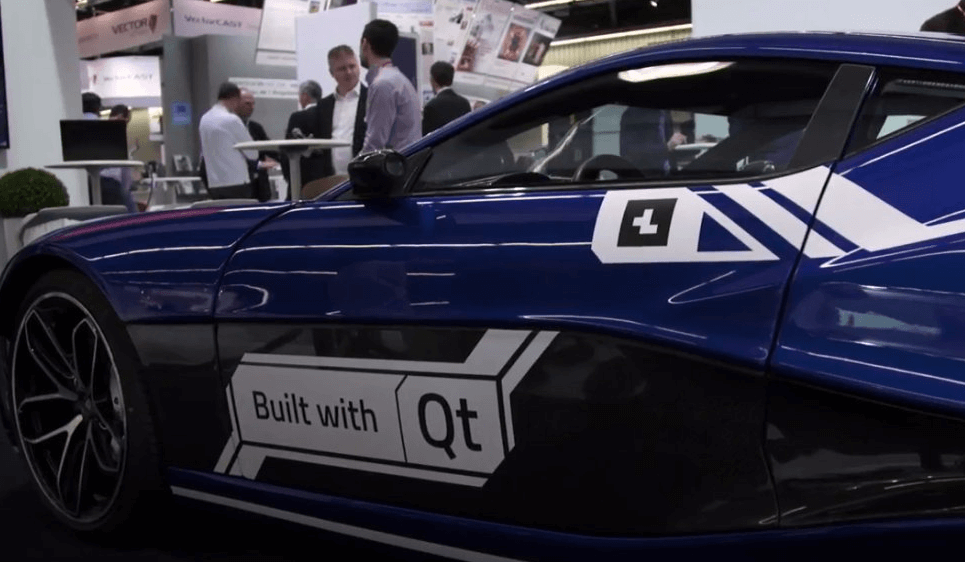As we wrote in the previous blog the Qt framework is one of the most popular tools for developing digital instrument clusters and in-vehicle infotainment systems (IVI). The acknowledgment is that the Qt framework is a member of Genivi Alliance where there are also such giants of the automotive industry such as BMW Group, Honda, Volvo and others. In order to achieve a dominant position in the automotive market the Qt company released its Qt Automotive Suite for developing clusters, IVI, Head Up Displays (HUD), Connected Car Environment and Navigation, and info systems. It allows to develop IVI systems faster and makes it more extendable. There are a lot of examples of commercial products in the automotive segment where Qt has been applied. Now we list just some of them.
Embedded Linux
Embedded Linux is the most popular operating system for building a vehicles virtual environment. It is a free, open source platform that allows developers to build their own commercial applications without any fees. There are several operating systems based on the embedded Linux customized specially for the automotive segment. Two such examples are:
Automotive Grade Linux or Evidence.
Automotive Grade Linux (AGL) is a collaborative open source project developed specially for automakers and suppliers. It is a Linux-based open software platform for automotive applications that can serve as the de facto industry standard. Adopting a shared platform across the industry reduces fragmentation and allows automakers and suppliers to reuse the same code base, leading to rapid innovation and faster time-to-market for new products. Initially, AGL was focused on infotainment. Now this platform can be used for infotainment, instrument cluster, heads-up-display (HUD), telematics, connected car, advanced driver assistance systems (ADAS), functional safety and autonomous driving.
Evidence is positioning itself as a fully open-source platform for automotive systems. It is a solution for automotive systems, consisting of Linux and Erika Enterprise (open-source Free RTOS) for hard real-time control. Evidence allows developers to combine the advantages of the general-purpose operating system (Linux), with the predictability and reliability of a certified RTOS. Erika Enterprise is the first OSEK/VDX-certified open-source RTOS, specifically designed for automotive and industrial control.

RTOS Integrity
The Integrity Real Time Operating System is an operating system developed by Green Hills Software for embedded development. Integrity is used both on infotainment systems as well as instrument clusters. The certified RTOS is a vital building block, especially in automotive instrument clusters as well as in other safety critical systems.
Concept One Electric Supercar
Toradex Company used the Qt framework for developing a IVI system for this amazing Rimac Automobili creation. The infotainment system features fast implementation of different graphics, display sizes, integrated internet connectivity for remote diagnostics, software updates, internet media streaming, web browsing and remote control (via smartphone app and web interfaces). With advanced features such as off-line 3D navigation, real-time vehicle telemetry, rear view-camera system these cars are truly top-of-the-line.

Neptune UI provides a UI implementation for Qt in IVI (In-Vehicle Infotainment) systems. It demonstrates best practicesfor developing an automotive UI with the Qt Automotive Suite.
Features of the Neptune UI include:
- Helps UI designers and software developers to work together.
- Provides methods for controlling the UI look-and-feel by UI designers, not only by developers.
- Makes the integration of Qt Automotive Suite Improve and external tools like maps, Qt IVI, 3D tools easy.
- Provides a multi-process UI that forms a base for an IVI system.
AutoIO Technology from China uses Qt to ease Human Machine Interface (HMI) design. AutoIO Technology is an LCD instrumentation solution provider, which targets their products for auto producers and vehicle users. The virtual auto instrumentation developed by AutoIO utilizes a hardware platform with an ARM processor, a software platform based on Linux and the Qt framework as its multi-platform application.
Secure & Connected Carputer produced by Link Motion. Motion T is a securely connected carputer with several displays. A single computer solution supports multiple displays, including the central unit, cluster, and HUD. Link Motion features include navigation, calls and messaging, music, rear-camera, air conditioning management, and browser. The system is positioned as low-cost based on NXP i.MX6.
Automated UI Development suite (HCAT) by Harman Company. The suite allows automakers to create connected, multi-screen and secure IVI systems. This application and UI framework is created based on Qt and has a flexible architecture as its key benefit. HCAT HMI allows automakers to develop expedient human-machine interfaces with more personalized user experiences. The toolchain includes advanced features like continuous build and test automation for rapid high-quality HMI builds. There is the ability to reuse HMI business logic across different vehicle models. It also provides support for different distributed system architectures such as Multi-SoC and Single SoC with Hypervisor.







